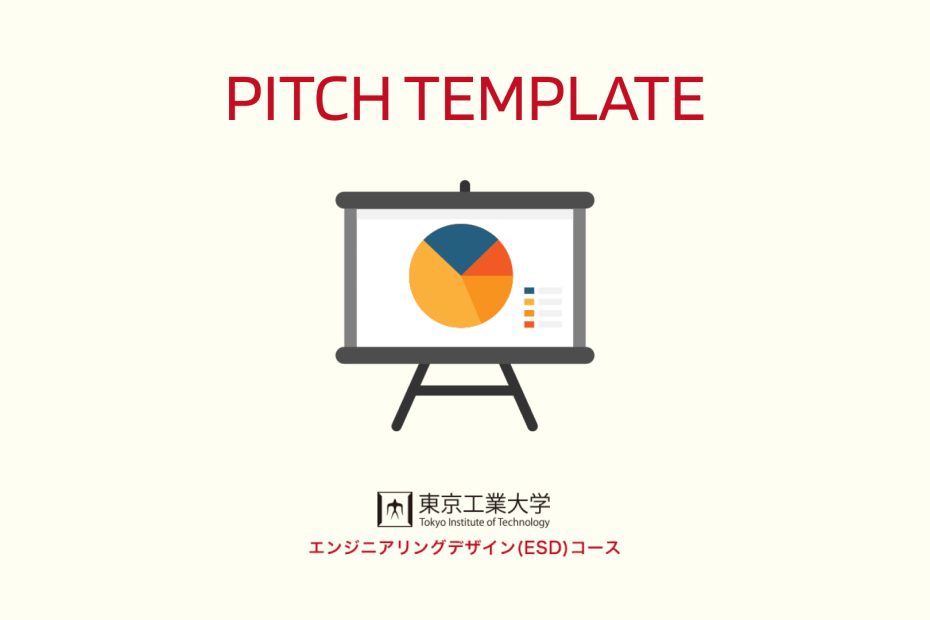プレゼンテーション用スライドのコンテンツやその構成のテンプレートを載せています。
Slide 0: Title/表紙
- Product Name and Tag Line/プロダクト名とタグライン
- Photo of your Prototype/プロトタイプの写真
- Design Prompt/デザインプロンプト
- Corporate Partner (if any)/ 協賛企業名(あれば)
- Team Name/チーム名
- Team Members/チームメンバー
- Date(For the regular classes)/日付
- The number of recent interviews/前回から行ったインタビュー数
- Total number of interviews/累計のインタビュー数
- The number of recent user tests/前回から行ったユーザーテスト数
- Total number of user tests/累計のユーザーテスト数
Slide 1: Prototype/プロトタイプ
- Photo of your Prototype / プロトタイプの画像
- Show and describe your prototype very concisely. / 簡潔にプロトタイプの説明を。
- Clearly state the people (target users) who will get the value. / 簡潔に価値提供を受けるユーザーの説明を。
- It would be better to use an Elevator Pitch Template below. / 以下のエレベーターピッチと呼ばれるフォーマットを使うと良い。
For [ target user ] who [ situation or needs ],
the [ product name ] is a [ product category ],
which has [ key benefit ].
Unlike [ competitive alternative ]
our product has [ unique differentiation ].これは { 現在、市場に流通している代替手段 } で問題を抱えている、
{ ターゲット顧客 } 向けの、
{ 新しい製品カテゴリー } の製品である。
この製品には { 問題を解決する能力 } がある。
そして { 対抗製品 }とは違って、
この製品には { 主要な機能 } が備わっている。Slide 2: Background/背景
- Clearly state the situation (context) you are researching. / 取り組んでいる課題のコンテクストを明確に説明する。
[WHO] under the condition of [WHAT] is doing [HOW]. Because [WHY].{ 状況 } にいて { 行動 } をしている { 人物 }。 なぜなら { 理由 }。🔨 Useful toolkits / 参考資料
- User Research Questions / ユーザーリサーチに使える質問
- AEIOU Summary
- User Journey Map
- User Needs / ユーザーニーズ
- POV and HMWQ / POVとHMWQ
Slide 3: Unique Insight/ユニークなインサイト
- Tell us what only you know through user research. / ユーザー調査して分かったことを伝えよう。
- You can use the last line of POV as insight. / POVの最後の部分はインサイトとして使える。
- “But actually”, “However”, “We wonder if this means” …
- You can use HMWQ as a part of the insight. / HMWQもインサイトの一部として使える。
🔨 Useful toolkits / 参考資料
Slide 4: Design Principles/デザイン原則
- What kind of “Design Principles” have you set to design the solution? / 解決案を考える時にどのようなデザイン原則に沿って思考した?
- You can use HMWQ as a Design principle. / HMWQはデザイン原則になり得る。
🔨 Useful toolkits / 参考資料
Slide5: Solution/解決案
- Features and Specifications. / 特徴な主な機能
- Describe the concrete benefits (especially user experience rather than the product itself) you provide. / どのような価値や便益をユーザーに提供できるか言い切ろう。(「どんなプロダクトか」ではない!)
- What are your differentiating factors? / あなたのプロダクトのユニークな点はどこ?
🔨 Useful toolkits / 参考資料
✔️ Checklist / チェックリスト
- Is your product tangible? / そのプロダクトはタンジブルなものですか?
- Does your product include engineering elements? / そのプロダクトにはエンジニアリング要素が入っていますか?
- Is the product feasible for your team? / そのプロダクトはチームで実現可能なものですか?
- Are there some similar products and the differentiating factors of your product? / そのプロダクトの類似製品と差別化要因は何ですか?
- Does the product successfully provide value? / そのプロダクトは本当に価値を提供していますか?
Slide6: User Story/ユーザーのストーリー
- Draw your storyboard using a four-panel comic format or Story Spine format.
🔨 Useful toolkits / 参考資料
✔️ Checklist / チェックリスト
- Is it clear that new experiences or behaviors are brought to users by providing value? / その価値を提供することで、ユーザーに生まれる「体験や行動」は明確ですか?
- Is there a story about how your product improved the experience or behavior of the user? / ユーザーの体験や行動が変わったことを示す物語はありますか?
Slide7: Voice of User/ユーザーの声
- How much does it solve the problem? Give us some evidence.
🔨 Useful toolkits / 参考資料
✔️ Checklist / チェックリスト
- Are there any data that supports your success (e.g. the result of the user test)? / 成功を裏付けるデータ(ユーザーテストの結果など)はありますか?
Slide8: Future Work/今後の予定
- Do you have any future plans?
🔨 Useful toolkits / 参考資料
Slide9: Ending and Call To Action/〆の呼びかけ
- Photo of your prototype (again). / プロトタイプの写真(しつこいけどもう一回)
- What do you want the audience to do next? / プレゼンを聞き終わった人が、次何をするべきかここで提示してあげる
- DO NOT end with just a “Thank you” slide. / 「ありがとうございました」でプレゼンを終わらなるな。視聴者に呼びかけろ!
Tips for the pitch/プレゼンテクニック
- You should have at most 3 pages per a slide (the title slide must be one page) / 一つのコンテンツにつきスライドは最大3枚。
- You can insert the video anywhere you want. / 動画はどこに入れてもOK
- It is appropriate to put it after the elevator pitch slide. / ただし、一般的にはピッチの後に入れることが多い。
- You SHOULD use the format of POV and/or HMWQ, but you SHOULD NOT use design thinking jargon (e.g. POV, HMW, or so) in your presentation. / POVやHMWQのフォーマットは使用すべきですが、デザイン思考の用語(例:POVやHMWQなど)はプレゼンに入れてはいけません。
- When creating a slide with a team, it is better to make it with something that everyone can edit at the same time, such as Google Slides. In addition, Google Slide looks like different fonts if you use a different OS, but you can solve it by using Japanese web fonts. Select [Japanese] from the [Other Fonts …] menu and select the font you want to use. / チームでスライドを作るときは、Googleスライド等みんなで同時編集できるもので作ったほうがよいです。なお、Googleスライドは使用するOSが違うとフォントが違って見えますが、日本語のウェブフォントを使うと解決できます。[その他のフォント…]メニューから[日本語]を選択して、使いたいフォントを選んでください。















